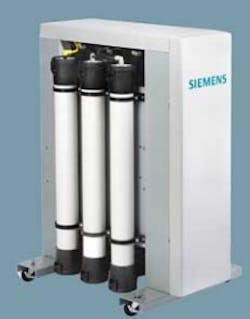High-Purity Water System Helps Manufacturer Save Money, Simplify Process
BY TRUDE WITHAM
Saint-Gobain Containers, of Milford, MA, was using separate and mixed-bed service deionizers to purify theThe IonRight system from Siemens is designed to produce 4-10 gpm of highpurity water from potable feed water.
The new the IonRight system has subsequently saved the company around $6,000 over 16 months.
“With our traditional service DI system, we had to have the water treatment vendor exchange our DI tanks every one to two weeks, but with the IonRight system, service visits have been cut back to every four to six weeks,†said Sherman Eastton, maintenance manager at Saint-Gobain. “During these service visits, the water treatment vendor checks system operation, changes the cartridge filters and takes a meter reading.â€
Saint-Gobain started with an alpha pilot system in January 2008, and switched to the beta (production prototype) system 10 months later. The 4 gpm system is providing high-purity water with less than 1.0 parts per million (ppm) of Total Dissolved Solids and conductivity of 2.0 microSiemens (ô€€€S/cm) for manufacturing glass containers used in the U.S. wine, beer, beverage, spirits and food industries.
The plant uses approximately 450,000 gallons of high-purity water per year for the bottle coating process. In this process, deionized water from the IonRight system is mixed with a surfactant-based chemical that is sprayed on the bottles during the cooling process to prevent the bottles from sticking together. The coating allows a smooth transition of the bottles through inspection and processing.
“The purity of the coating mixture is important to maintain bottle quality. Therefore, the water used to make up the mixture can’t contain any hardness, but must be 2.0 μS/cm at all times. For this reason, the IonRight system is set up so that if for some reason it should fail, the system will shut down and the process will revert to the back-up filters,†Eastton said. “There is also a conditioning filter bed for the hard water from the city and a safety filter for any failures on the effluent end of the IonRight system, which prevents any chance of contaminated water getting into the coating system.â€
The IonRight system, introduced for commercial sale in early 2009, is an alternative to portable separate-bed or mixedbed deionization. Designed to produce 4-10 gpm of high-purity water from potable feed water, the system incorporates activated carbon, reverse osmosis (RO) and continuous electrodeionization (CEDI) technologies, as well as an integrated control panel and power supply, in a compact skid-mounted design. Multiple systems can be installed in parallel to provide higher flow rates. The dual-filtration technology results in lower operating costs than with traditional service deionization, and maintenance is minimal, as the system is cleaned at the vendor’s site, when required.
The system works as follows: After being connected to the customer’s feed water source, the water enters a carbon pretreatment vessel that removes chlorine, chloramine and other organics that could damage the RO and CEDI membranes. The water then flows into the RO membrane housing where the bulk of the dissolved solids are removed. From there, the water enters the CEDI vessel, where it is “polished†to a purity level of 1􀀀S/cm or greater.
Unlike conventional deionization, CEDI produces consistent high-purity water without the need for acid and caustic regeneration chemicals or the need to exchange deionization tanks.
“Besides the fact that the IonRight system saves us money in operating costs, we also like the fact that it is an eco-friendly device,†said Eastton. “Our plant is very conscious of water usage, and anything that goes into the basement system is returned to the city. We are currently using a program called Kaizen that involves recycling cardboard, metal, etc. But, more importantly, the plant recycles a very high percentage of bottles in each batch.â€
Eastton said he is happy with the IonRight system so far.
“The alpha system ran continuously with no issues. The beta system had a few minor problems, but they were resolved and we’ve been happy with its performance,†he said.
Saint-Gobain, the second largest glass container manufacturer in the U.S., with 14 plants, state-of-the-art machine shop and distribution center, is a forwardthinking company that recently won an EPA Energy Star Partner of the Year award (the first glass company to do so) for its commitment to energy management and efficiency. The company was also featured on the “World’s Greatest!...†television program that highlights the world’s greatest companies, products, places and people. Saint-Gobain has produced more than 50-award winning packaging designs since 1989 that have been recognized through the Glass Packaging Institute’s (GPI) Clear Choice Awards program.
About the Author: Trude Witham is senior technical writer with Siemens Water Technologies, based in Lowell, Massachusetts. She can be reached at [email protected].

